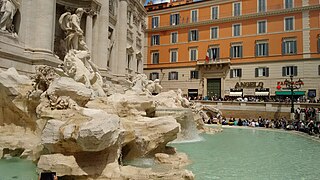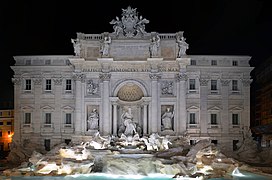Trevi Fountain
The Trevi Fountain , Fontana di Trevi in Italian , is the most popular and, at around 26 meters high and 50 meters wide, the largest fountain in Rome and one of the most famous fountains in the world.
It was built from 1732 to 1762 according to a design by Nicola Salvi in late Baroque style , in transition to the classicist style, following the Palazzo Poli . It is one of the most important sights in Rome.
prehistory

In 19 BC In BC the consul Marcus Agrippa had the aqueduct Aqua Virgo built next to the Pantheon to supply the thermal baths he had built. This aqueduct, the only one that has been in continuous operation since ancient times, carries water from the Sabine Mountains over a distance of 26 kilometers to Rome.
By the 12th century at the latest, three exits, with which the water pipe ended, fed well troughs on today's Via del Corso. The name Trevi for the district and the fountain could refer to these three sources or to the intersection of three streets (Italian: tre vie ) nearby.
In 1453, after restoration work , Pope Nicholas V gave the aqueduct a new end point. Leon Battista Alberti built a facade with an inscription and the Pope's coat of arms, from which the water poured from three spiers into a simple, right-angled fountain basin.
Pope Pius IV initiated the fundamental renovation of the aqueduct from the source to the city, which was carried out between 1561 and 1570.
In 1640, Gian Lorenzo Bernini began building a more elaborate fountain at the current location on behalf of Pope Urban VIII . For lack of money, however, only the square was enlarged and a large, shallow well basin was built. Around the same time, the Counts Conti di Poli built the two wings of their palace next to the fountain.
Today's well
After several unsuccessful attempts to rebuild the fountain, Pope Clement XII praised . organized an architecture competition in which many well-known architects of the time participated. Surprisingly, Clemens awarded the contract to the unknown Nicola Salvi . Salvi (1697–1751) had hardly built any buildings until then. He began work on the fountain in 1732, the facade of which is based on the Palazzo Poli in full length. He was supported by his friend Luigi Vanvitelli .
The Count of Poli protested against the building because this new palace facade took no account of the architecture of its buildings, especially the height of the floors. But this protest was rejected.
In 1735 Pope Clement XII consecrated. the new well, although the work was still in full swing. Even after his death in 1740, the work was halted under Pope Benedict XIV . Recurring financing problems were not only to blame for the long construction period, Salvis' extremely meticulous way of working also contributed to this. For example, he had some parts of the rocky landscape rebuilt up to ten times until he was satisfied with it. From 1744 onwards his deteriorating health made progress difficult.
Salvi died in 1751, Giuseppe Pannini completed his plans until completion in 1762. Only the sculpture of Oceanus was redesigned by Pietro Bracci , as the original design seemed too brawny and brutal to Pope Benedict.
In the years 1872, 1989–1991 and 1999 the fountain was renovated.
Due to structural damage in June 2007, the Acqua Vergine water line , which had previously supplied the fountain with water, was interrupted. The Trevi Fountain was then filled with regular tap water, which ran through the fountain by means of a circulation pump and only had to be renewed every two weeks. It was only through this closed cycle that a color attack in October 2007 by the artist Graziano Cecchini was able to achieve its effect and color the entire water deep red for hours. With the old technique, the paint would have been washed away in a few minutes. Cecchini repeated the color attack in October 2017.
Since the renovation of the Trevi Fountain in 2015, the Acqua Vergine has been feeding the fountain's large basin again, while the water features are operated by a circulation pump. A water softening system was also installed.
architecture
The Trevi Fountain consists of a palace facade with a triumphal arch in front. In front of it, sea figures cavort on a rocky landscape, over which the water pours into a large, flat basin. The material used is travertine from Tivoli and marble from Carrara .
The Trevi Fountain is the third fountain in Rome to use the triumphal arch motif as the end point of a renovated ancient aqueduct. Salvi developed the models, the Moses Fountain (completed in 1587) and the Fontana Paola (completed in 1613), and carried out their architectural principle in a more monumental form.
Salvis' theme was the forces of nature that threaten human work. On the right side, the facade seems to be breaking through the erupting rocks. The dramatic effect is intensified by the sound of the sea generated by the flowing water, which can already be heard in the side streets. Salvi experimented for a long time with which stone surface he could achieve this effect despite the relatively small amount of water. All sorts of mythical creatures of the sea such as sea horses and tritons are arranged on the rocks and rush towards the viewer. Above them in the center is the lordly sea god Oceanus, already in the middle niche of the triumphal arch.
The triumphal arch is a reinterpretation of the Arch of Constantine . In the niches to the right and left of the Oceanus there are figures created by Filippo della Valle , which symbolize health and fertility. Above each there is a relief. On the right a virgo (Latin virgo , hence the name Aqua Virgo) shows soldiers of Agrippa the spring in the Sabine mountains . On the left Agrippa orders the construction of the aqueduct. Four figures stand on the architrave , depicting as allegories from right to left the lush meadows, the gifts of autumn, the fertility of the fields and the abundance of fruits. The inscriptions pay homage to the popes involved in the construction. The fountain is crowned with the coat of arms of Clemens XII.
Surroundings
The effect of the fountain is increased by the rising level of Piazza Trevi, so that when one walks around the fountain, one experiences the scenery from constantly changing angles. The opposite church of Santi Vincenzo e Anastasio forms the counterpoint with its unusual facade with many closely spaced columns.
A few meters away in Vicolo del Putarello, part of the Acqua Vergine and remains of residential houses from the imperial era were excavated when a cinema was being built. The complex can be visited under the name Città del'Acqua .
About 20 meters to the northeast is the baroque church of Santa Maria in Trivio with frescoes by Antonio Gherardi .
Restoration work
Due to extreme climatic fluctuations in past years and recurring acts of vandalism, the Trevi Fountain was noticeably damaged, so that in June 2012 some parts of the cornice came loose from the fountain and concerns about the stability of the statues arose.
From June 5, 2014 to November 3, 2015, the Trevi Fountain was completely renovated, which was financed by the Italian fashion group Fendi with 2.18 million euros.
On September 18, 2019, a new lighting system based on LED technology was inaugurated.
Legends
According to legend, Agrippa and his soldiers are said to have rested on their return from the sea battle against Cleopatra and Mark Antony in the Sabine Mountains when a virgin (Latin virgo ) showed them a source with particularly pure water - the source of the Aqua Virgo.
Salvi is said to have set up the large vase in front of the right corner of the facade to block the view of the fountain for a hairdresser who had his shop behind it and who had annoyed him.
There is a popular belief that throwing coins over your shoulder into the well is good for luck. One coin leads to a safe return to Rome, two coins to the thrower falling in love with a Roman, three coins to a marriage with the person in question. Originally there was the custom of taking a sip from the well to return to Rome.
The coins are regularly taken out of the water by officials of the city of Rome. In 2013, the last year before the restoration, 1.2 million euros were raised. According to current contracts, the money will be donated to Caritas until at least 2019 .
Movies
In Fellini's La Dolce Vita ( The Sweet Life ) from 1960, Anita Ekberg takes a nightly bath in the fountain with Marcello Mastroianni . This is one of the most famous scenes in film history, which has contributed to the popularity of the fountain with tourists.
The custom of throwing coins, was the American film Three Coins in the Fountain ( Three Coins in the Fountain popular) from the year 1954th
In the film Totòtruffa 62 , the Italian comedian Totò tries to sell the Trevi Fountain to a tourist. The fountain was caricatured as a tourist magnet back then.
In the music video for the title Pfüati Gott, Elisabeth from 1984 by the German band Spider Murphy Gang , the singer sits in a tuxedo with a black eye in the pool of the Trevi Fountain.
The fountain also appears in scenes from numerous films such as A Heart and a Crown and in the music video for Thank You For Loving Me by Bon Jovi .
Trivia
In Caesars Palace in Las Vegas, the Trevi Fountain was recreated alongside other Roman sights.
On June 20, 2003, Anita Ekberg threw a first coin into the fountain basin in Berlin to restart the fountain on Hausvogteiplatz and in reference to her famous film scene.
The toy manufacturer Lego created the Trevi Fountain alongside other architectural icons such as the Villa Savoye , the Seattle Space Needle or the Brandenburg Gate as a 731-piece model as part of its "Architecture" series.
gallery
literature
- Heinz-Joachim Fischer : Rome. Two and a half millennia of history, art and culture of the Eternal City. DuMont Buchverlag, Cologne 2001, ISBN 3-7701-5607-2 , pp. 210-211.
- Anton Henze : Art Guide Rome. Philipp Reclam GmbH, Stuttgart 1994, ISBN 3-15-010402-5 , pp. 279-280.
Web links
- Site of the Roman Monument Authority (Italian)
- Salvi and the Trevi Fountain (German)
- The Città del'Acqua excavations
- The Trevi Fountain as a 3D model in SketchUp's 3D warehouse
Individual evidence
- ^ Der Tagesspiegel, June 17, 2007
- ↑ Der Tagesspiegel, October 27, 2017
- ^ Homepage of the ACEA water supply company in Rome, Italian, accessed on March 15, 2018
- ^ Anton Henze, Art Guide Rome, p. 324
- ↑ Restoration of the Trevi Fountain in Rome begins. kleinezeitung.at, June 4, 2014, accessed on April 21, 2020 .
- ↑ La Fontana di Trevi, applauso e flash salutano il ritorno dell'acqua. ANSA , November 3, 2015, accessed November 4, 2015 (Italian).
- ↑ Nuova illuminazione della Fontana di Trevi, il momento dell'accensione delle luci. video.corriere.it of September 19, 2019 (Italian, video), accessed on September 20, 2019
- ^ Deutsche Welle (www.dw.com): Trevi Fountain remains a church source of money for the time being | DW | 04/03/2018. Retrieved May 26, 2018 .
- ^ Internet Movie Database
- ↑ https://www.youtube.com/watch?v=xFj-iaSQc6A
- ↑ Senate Department for Urban Development and the Environment , accessed on June 9, 2015.
- ↑ The Trevi Fountain in bright red. Die Welt , October 19, 2007, accessed on February 4, 2018 .
Coordinates: 41 ° 54 ′ 3.4 " N , 12 ° 28 ′ 59.9" E











